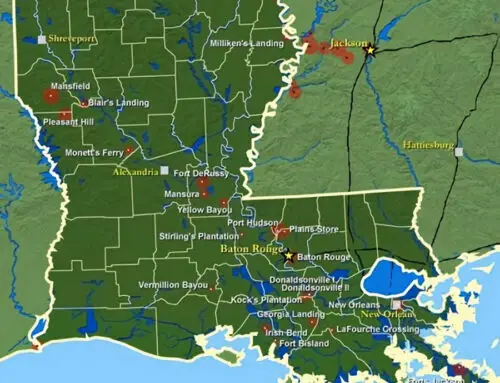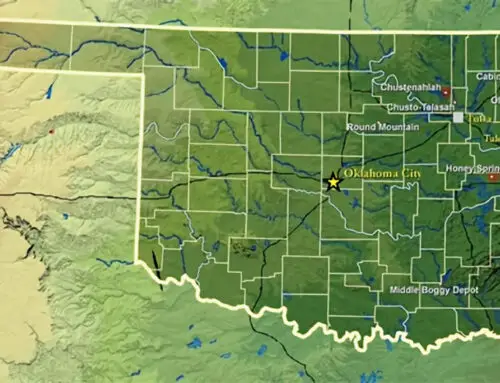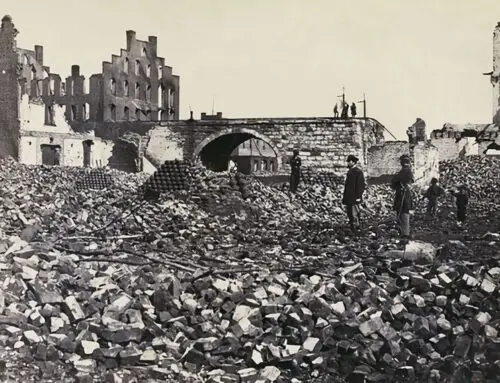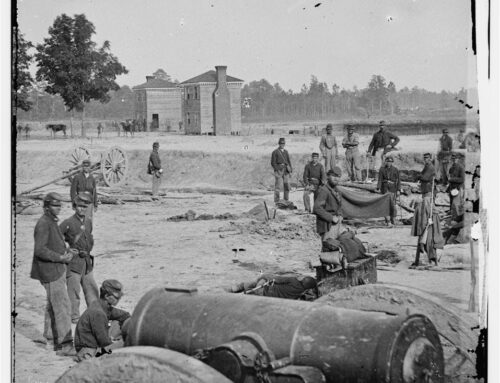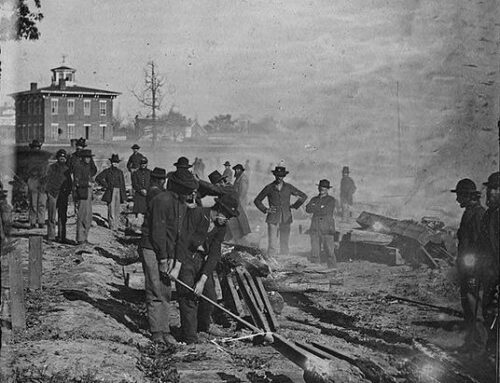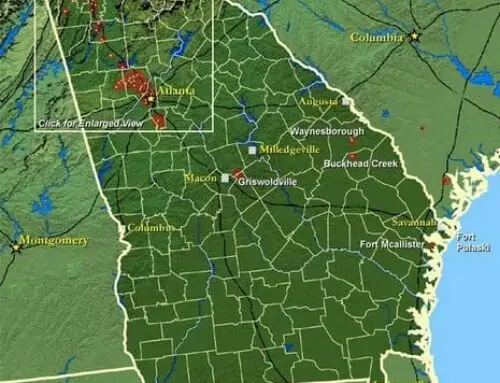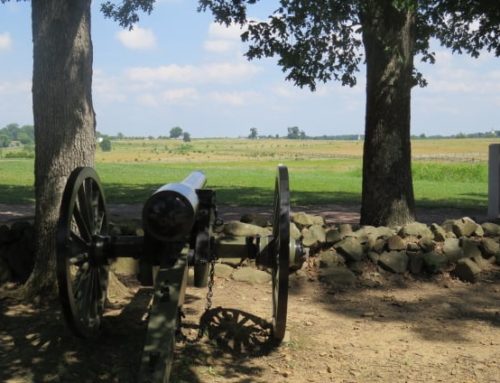All Civil War battles in Missouri. They are listed in the order in which they occurred.
Boonville
Civil War battles in Missouri
Other Names: First Battle of Boonville
Location: Cooper County
Campaign: Operations to Control Missouri (1861)
Date(s): June 17, 1861
Principal Commanders: Brig. Gen. Nathaniel Lyon [US]; Col. John S. Marmaduke [CS]
Forces Engaged: Combined force of Missouri troops and Regular U.S. Army (approx. 1,700) [US]; State Guard Troops [CS]
Estimated Casualties: 81 total (US 31; CS 50)
Description: Claiborne Jackson, the pro-Southern Governor of Missouri, wanted the state to secede and join the Confederacy. Union Brig. Gen. Nathaniel Lyon set out to put down Jackson’s Missouri State Guard, commanded by Sterling Price. Reaching Jefferson City, the state capital, Lyon discovered that Jackson and Price had retreated towards Boonville. Lyon reembarked on steamboats, transported his men to below Boonville, marched to the town, and engaged the enemy. In a short fight, Lyon dispersed the Confederates, commanded on the field by Col. John S. Marmaduke, and occupied Boonville. This early victory established Union control of the Missouri River and helped douse attempts to place Missouri in the Confederacy.
Result(s): Union victory
Carthage
Civil War battles in Missouri
Other Names: None
Location: Jasper County
Campaign: Operations to Control Missouri (1861)
Date(s): July 5, 1861
Principal Commanders: Col. Franz Sigel [US]; Governor Claiborne Jackson [CS]
Forces Engaged: Brigade [US]; Missouri State Guard divisions [CS]
Estimated Casualties: 244 total (US 44; CS 200)
Description: Brig. Gen. Nathaniel Lyon had chased Governor Claiborne Jackson and approximately 4,000 State Militia from the State Capital at Jefferson City and from Boonville, and pursued them. Col. Franz Sigel led another force of about 1,000 into southwest Missouri in search of the governor and his loyal troops. Upon learning that Sigel had encamped at Carthage, on the night of July 4, Jackson took command of the troops with him and formulated a plan to attack the much smaller Union force. The next morning, Jackson closed up to Sigel, established a battle line on a ridge ten miles north of Carthage, and induced Sigel to attack him. Opening with artillery fire, Sigel closed to the attack. Seeing a large Confederate force actually unarmed recruits moving into the woods on his left, he feared that they would turn his flank. He withdrew. The Confederates pursued, but Sigel conducted a successful rearguard action. By evening, Sigel was inside Carthage and under cover of darkness; he retreated to Sarcoxie. The battle had little meaning, but the pro-Southern elements in Missouri, anxious for any good news, championed their first victory.
Result(s): Confederate victory
Liberty
Civil War battles in Missouri
Other Names: Blue Mills Landing, Blue Mills
Location: Clay County
Campaign: Operations to Control Missouri (1861)
Date(s): September 17, 1861
Principal Commanders: Lt. Col. John Scott [US]; General D.R. Atchison (Atkinson) [CS]
Forces Engaged: Detachments of 3rd Iowa Infantry, Home Guards, and artillery (approx. 600 men) [US]; 4th Division, Missouri State Guard [CS]
Estimated Casualties: 126 total (US 56; CS 70)
Description: General D.R. Atchison left Lexington on September 15, 1861, and proceeded to Liberty where he met the Missouri State Guard. On the night of September 16-17, his force crossed the Missouri River to the south side and prepared for a fight with Union troops reported to be in the area. At the same time, Union Lt. Col. John Scott led a force of about 600 men from Cameron, on the 15th, towards Liberty. He left his camp in Centreville, at 2:00 am on the 17th. He arrived in Liberty, sent scouts out to find the enemy, and, about 11:00 am, skirmishing began. At noon, Scott marched in the direction of the firing, approached Blue Mills Landing and, at 3:00 am, struck the Confederate pickets. The Union force began to fall back, though, and the Rebels pursued for some distance. The fight lasted for an hour. The Confederates were consolidating influence in northwestern Missouri.
Result(s): Confederate victory
Wilson’s Creek
Civil War battles in Missouri
Other Names: Oak Hills
Location: Greene County and Christian County
Campaign: Operations to Control Missouri (1861)
Date(s): August 10, 1861
Principal Commanders: Brig. Gen. Nathaniel Lyon and Maj. Gen. Samuel D. Sturgis [US]; Maj. Gen. Sterling Price, Missouri State Guard, and Brig. Gen. Ben McCulloch [CS]
Forces Engaged: Army of the West [US]; Missouri State Guard and McCulloch’s Brigade [CS]
Estimated Casualties: 2,330 total (US 1,235; CS 1,095)
Description: Brig. Gen. Nathaniel Lyon’s Army of the West was camped at Springfield, Missouri, with Confederate troops under the commands of Brig. Gen. Ben McCulloch approaching. On August 9, both sides formulated plans to attack the other. About 5:00 am on the 10th, Lyon, in two columns commanded by himself and Col. Franz Sigel, attacked the Confederates on Wilson’s Creek about 12 miles southwest of Springfield. Rebel cavalry received the first blow and fell back away from Bloody Hill. Confederate forces soon rushed up and stabilized their positions. The Confederates attacked the Union forces three times that day but failed to break through the Union line. Lyon was killed during the battle and Maj. Samuel D. Sturgis replaced him. Meanwhile, the Confederates had routed Sigel’s column, south of Skegg’s Branch.
Following the third Confederate attack, which ended at 11:00 am, the Confederates withdrew. Sturgis realized, however, that his men were exhausted and his ammunition was low, so he ordered a retreat to Springfield. The Confederates were too disorganized and ill-equipped to pursue. This Confederate victory buoyed southern sympathizers in Missouri and served as a springboard for a bold thrust north that carried Price and his Missouri State Guard as far as Lexington. In late October, a rump convention, convened by Governor Claiborne Fox Jackson, met in Neosho and passed an ordinance of secession. Wilson’s Creek, the most significant 1861 battle in Missouri, gave the Confederates control of southwestern Missouri.
Result(s): Confederate victory
Dry Wood Creek
Civil War battles in Missouri
Other Names: Big Dry Wood Creek, Battle of the Mules
Location: Vernon County
Campaign: Operations to Control Missouri (1861)
Date(s): September 2, 1861
Principal Commanders: Col. J.H. Lane [US]; Maj. Gen. Sterling Price and Brig. Gen. James S. Rains [CS]
Forces Engaged: Kansas Cavalry Brigade (approx. 600) [US]; column of Missouri State Guard [CS]
Estimated Casualties: Total unknown (US 14; CS unknown)
Description: Col. J.H. Lane’s cavalry, comprising about 600 men, set out from Fort Scott to learn the whereabouts of a rumored Confederate force. They encountered a Confederate force, about 6,000-strong, near Big Dry Wood Creek. The Union cavalry surprised the Confederates, but their numerical superiority soon determined the encounter’s outcome. They forced the Union cavalry to retire and captured their mules, and the Confederates continued on towards Lexington. The Confederates were forcing the Federals to abandon southwestern Missouri and to concentrate on holding the Missouri Valley.
Result(s): Confederate victory
Lexington
Civil War battles in Missouri
Other Names: Battle of the Hemp Bales
Location: Lafayette County
Campaign: Operations to Control Missouri (1861)
Date(s): September 13-20, 1861
Principal Commanders: Col. James A. Mulligan [US]; Maj. Gen. Sterling Price [CS]
Forces Engaged: Garrison (approx. 3,500) [US]; Missouri State Guard (12,000) [CS]
Estimated Casualties: 1,874 total (US 1,774; CS 100)
Description: Following the victory at Wilson’s Creek, the Confederate Missouri State Guard, having consolidated forces in the northern and central part of the state, marched, under the command of Maj. Gen. Sterling Price, on Lexington. Col. James A. Mulligan commanded the entrenched Union garrison of about 3,500 men. Price’s men first encountered Union skirmishers on September 13 south of town and pushed them back into the fortifications. Price, having bottled the Union troops up in Lexington, decided to await his ammunition wagons, other supplies, and reinforcements before assaulting the fortifications. By the 18th, Price was ready and ordered an assault.
The Missouri State Guard moved forward amidst heavy Union artillery fire and pushed the enemy back into their inner works. On the 19th, the Rebels consolidated their positions, kept the Yankees under heavy artillery fire and prepared for the final attack. Early on the morning of the 20th, Price’s men advanced behind mobile breastworks, made of hemp, close enough to take the Union works at the Anderson House in a final rush. Mulligan requested surrender terms after noon, and by 2:00 pm his men had vacated their works and stacked their arms. This Unionist stronghold had fallen, further bolstering southern sentiment and consolidating Confederate control in the Missouri Valley west of Arrow Rock.
Result(s): Confederate victory
Fredericktown
Civil War battles in Missouri
Other Names: None
Location: Madison County
Campaign: Operations to Control Missouri (1861)
Date(s): October 21, 1861
Principal Commanders: Col. J.B. Plummer and Col. William P. Carlin [US]; Brig. Gen. M. Jeff Thompson [CS]
Forces Engaged: Brigade size force (approx. 2,500-3,500) [US]; Missouri State Guard [CS]
Estimated Casualties: Total unknown (US unknown; CS 62)
Description: Two Union columns, one under Col. J.B. Plummer and another under Col. William P. Carlin, advanced on Fredericktown to overtake Brig. Gen. M. Jeff Thompson and his men. On the morning of October 21, Thompson’s force left Fredericktown headed south. About twelve miles out, Thompson left his supply train in a secure position and returned toward Fredericktown. He then learned that Union forces had occupied Fredericktown, so Thompson spent the morning attempting to discern the enemy numbers and disposition. Unable to do so, he attacked anyway, around noon. Plummer, with his force and a detachment of Col. William P. Carlin’s troops, met the Rebel forces outside town and a two-hour fight ensued. Overwhelming Union forces took their toll, and Thompson’s men retreated. Union cavalry pursued. Fredericktown cemented Union control of southeastern Missouri.
Result(s): Union victory
Springfield
Civil War battles in Missouri
Other Names: Zagonyi’s Charge
Location: Greene County
Campaign: Operations to Control Missouri (1861)
Date(s): October 25, 1861
Principal Commanders: Maj. James Zagonyi [US]; Col. James Frazier [CS]
Forces Engaged: Prairie Scouts and Frémont’s Body Guard [US]; Missouri State Guard troops [CS]
Estimated Casualties: 218 total (US 85; CS 133)
Description: Having accomplished little since taking command of the Western Department, with headquarters in St. Louis, Missouri, Maj. Gen. John C. Frémont formulated a plan to clear Maj. Gen. Sterling Price’s Rebels from the state and then, if possible, carry the war into Arkansas and Louisiana. Leaving St. Louis on October 7, 1861, Frémont’s combined force eventually numbered more than 20,000. His accompanying cavalry force, numbering 5,000 men and other mounted troops, included Maj. Frank J. White’s Prairie Scouts and Frémont’s Body Guards under Maj. Charles Zagonyi. Maj. White became ill and turned his command over to Zagonyi.
These two units operated in front of Frémont’s army to gather intelligence. As Frémont neared Springfield, the local state guard commander, Col. Julian Frazier, sent out requests to nearby localities for additional troops. Frémont camped on the Pomme de Terre River, about 50 miles from Springfield. Zagonyi’s column, though, continued on to Springfield, and Frazier’s force of 1,000 to 1,500 prepared to meet it. Frazier set up an ambush along the road that Zagonyi travelled, but the Union force charged the Rebels, sending them fleeing. Zagonyi’s men continued into town, hailed Federal sympathizers and released Union prisoners. Leery of a Confederate counterattack, Zagonyi departed Springfield before night, but Frémont’s army returned, in force, a few days later and set up camp in the town. In mid-November, after Frémont was sacked and replaced by Maj. Gen. Hunter, the Federals evacuated Springfield and withdrew to Sedalia and Rolla. Federal troops reoccupied Springfield in early 1862 and it was a Union stronghold from then on. This engagement at Springfield was the only Union victory in southwestern Missouri in 1861.
Result(s): Union victory
Belmont
Civil War battles in Missouri
Other Names: None
Location: Mississippi County
Campaign: Operations at the Ohio and Mississippi River Confluence (1861)
Date(s): November 7, 1861
Principal Commanders: Brig. Gen. Ulysses S. Grant [US]; Brig. Gen. Gideon J. Pillow [CS]
Forces Engaged: Division [US]; division [CS]
Estimated Casualties: 1,464 total (US 498; CS 966)
Description: On November 6, 1861, Brig. Gen. U.S. Grant left Cairo, Illinois, by steamers, in conjunction with two gunboats, to make a demonstration against Columbus, Kentucky. The next morning, Grant learned that Confederate troops had crossed the Mississippi River from Columbus to Belmont, Missouri, to intercept two detachments sent in pursuit of Brig. Gen. M. Jeff Thompson and, possibly, to reinforce Maj. Gen. Sterling Price’s force. He landed on the Missouri shore, out of the range of Confederate artillery at Columbus, and started marching the mile to Belmont. At 9:00 in the morning, an engagement began. The Federals routed the Confederates out of their Belmont cantonment and destroyed the Rebel supplies and equipment they found because they did not have the means to carry them off. The scattered Confederate forces reorganized and received reinforcements from Columbus. Counterattacked by the Confederates, the Union force withdrew, reembarked, and returned to Cairo. Grant did not accomplish much in this operation, but, at a time when little Union action occurred anywhere, many were heartened by any activity.
Result(s): Union victory
Mount Zion Church
Civil War battles in Missouri
Other Names: None
Location: Boone County
Campaign: Operations in Northeast Missouri (1861-62)
Date(s): December 28, 1861
Principal Commanders: Brig. Gen. Benjamin M. Prentiss [US]; Col. Caleb Dorsey [CS]
Forces Engaged: Detachments of the 3rd Missouri Cavalry Regiment (approx. 240) and Birge’s Sharpshooters (approx. 200) [US]; unknown [CS]
Estimated Casualties: 282 total (US 72; CS 210)
Description: Brig. Gen. Benjamin M. Prentiss led a Union force of 5 mounted companies and 2 companies of Birge’s sharpshooters into Boone County to protect the North Missouri Railroad and overawe secessionist sentiment there. After arriving in Sturgeon on December 26, Prentiss learned of a band of Rebels near Hallsville. He sent a company to Hallsville the next day that fought a Confederate force under the command of Col. Caleb Dorsey and suffered numerous casualties, including many taken prisoner, before retreating to Sturgeon. On the 28th, Prentiss set out with his entire force to meet Dorsey’s Rebels. He routed one company of Confederates on the road from Hallsville to Mount Zion and learned that the rest of the force was at Mount Zion Church. Prentiss headed for the church. After a short battle, the Confederates retreated, leaving their killed and wounded on the battlefield and abandoning many animals, weapons, and supplies. This action and others curtailed Rebel recruiting activities in Central Missouri.
Result(s): Union victory
Roan’s Tan Yard
Civil War battles in Missouri
Other Names: Silver Creek
Location: Randolf County
Campaign: Operations in Northeast Missouri (1861-62)
Date(s): January 8, 1862
Principal Commanders: Maj. W.M.G. Torrence [US]; Col. J.A. Poindexter [CS]
Forces Engaged: Detachments from the 1st and 2nd Missouri Cavalry, 4th Ohio Cavalry, and 1st Iowa Cavalry (450) [US]; unknown [CS]
Estimated Casualties: 91 total (US 11; CS 80)
Description: Rumors and sightings of a Confederate force in the Howard County area had circulated for more than a week, but the Union troops could not locate them. On January 7, 1862, information came to hand that Col. J.A. Poindexter and his Confederate force were camped on Silver Creek. Detachments from various Union units came together and headed towards the Confederate camp which was about 14 miles northwest of Fayette. After finding the camp, the force attacked, routing the enemy and sending those that were not killed, wounded, or captured fleeing for safety. Afterwards, the Union force destroyed the camp to prevent its further use. The Confederates could no longer use their Randolph County base for recruiting and raiding.
Result(s): Union victory
New Madrid/Island No. 10
Civil War battles in Missouri
Other Names: None
Location: City of New Madrid, Missouri; Lake County, Tennessee
Campaign: Joint Operations on the Middle Mississippi River (1862)
Date(s): February 28-April 8, 1862
Principal Commanders: Brig. Gen. John Pope and Flag-Officer Andrew H. Foote [US]; Brig. Gen. John P. McCown and Brig. Gen. William W. Mackall [CS]
Forces Engaged: Army of the Mississippi [US]; Garrisons of New Madrid and Island No. 10 [CS]
Estimated Casualties: Unknown
Description: With the surrender of Forts Henry and Donelson, Tennessee, and the evacuation of Columbus, Kentucky, Gen. P.G.T. Beauregard, commander of the Confederate Army of the Mississippi, chose Island No. 10, about 60 river miles below Columbus, to be the strongpoint for defending the Mississippi River. Nearby was New Madrid, one of the weak points. Brig. Gen. John Pope, commander of the Union Army of the Mississippi, set out from Commerce, Missouri, to attack New Madrid, on February 28. The force marched overland through swamps, lugging supplies and artillery, reached the New Madrid outskirts on March 3, and laid siege to the city. Brig. Gen. John P. McCown, the garrison commander, defended both New Madrid and Island No. 10 from the fortifications.
He launched a sortie, under Brig. Gen. M. Jeff Thompson, Missouri State Guard, against the besiegers and brought up heavy artillery to bombard them. On the 13th, the Confederates bombarded the Yankees to no avail. Since it did not appear possible to defend New Madrid, the Confederate gunboats and troops evacuated to Island No. 10 and Tiptonville. On the 14th, Pope’s army discovered that New Madrid was deserted and moved in to occupy it. A U.S. Navy flotilla, under the command of Flag-Officer Andrew H. Foote, arrived March 15 upstream from Island No. 10. The ironclad Carondelet on the night of April 4 passed the Island No. 10 batteries and anchored off New Madrid. Pittsburgh followed on the night of April 6. The ironclads helped to overawe the Confederate batteries and guns, enabling Pope’s men to cross the river and block the Confederate escape route. Brig. Gen. William W. Mackall, who replaced McCown, surrendered Island No. 10 on April 8. The Mississippi was now open down to Fort Pillow, Tennessee.
Result(s): Union victory
Kirksville
Civil War battles in Missouri
Other Names: None
Location: Adair County
Campaign: Operations North of Boston Mountains (1862)
Date(s): August 6-9, 1862
Principal Commanders: Col. John McNeil [US]; Col. Joseph C. Porter [CS]
Forces Engaged: Combined force (cavalry and artillery) [US]; Missouri Brigade [CS]
Estimated Casualties: 456 total (US 88; CS 368)
Description: Col. John McNeil and his troops, numbering about 1,000, had been pursuing Col. Joseph C. Porter and his Confederate Missouri Brigade of 2,500 men for more than a week. Before noon on August 6, McNeil attacked Porter in the town of Kirksville, where his men had hidden themselves in homes and stores and among the crops in the nearby fields. After almost three hours of fighting, the Yankees secured the town, captured numerous prisoners, and chased the others away. Three days later, another Union force met and finished the work begun at Kirksville, destroying Porter’s command. Kirksville helped consolidate Union dominance in northeastern Missouri.
Result(s): Union victory
Independence
Civil War battles in Missouri
Other Names: None
Location: Jackson County
Campaign: Operations North of Boston Mountains (1862)
Date(s): August 11, 1862
Principal Commanders: Lt. Col. James T. Buel [US]; Col. J.T. Hughes and Col. G.W. Thompson [CS]
Forces Engaged: Garrison (approx. 300 [US]; 700-800[CS])
Estimated Casualties: Total unknown (US approx. 344; CS unknown)
Description: On August 11, 1862, Col. J.T. Hughes’s Confederate force, including William Quantrill, attacked Independence, at dawn, in two columns on different roads. They drove through the town to the Union Army camp, capturing, killing, and scattering the Yankees. Lt. Col. James T. Buel, commander of the garrison, attempted to hold out in one of the buildings with some of his men. Soon the building next to them was on fire, threatening them. Buel then, by means of a flag of truce, arranged a meeting with the Confederate commander, Col. G.W. Thompson, who had replaced Col. J.T. Hughes, killed earlier. Buel surrendered and about 150 of his men were paroled, the others had escaped, hidden, or been killed. Having taken Independence, the Rebel force headed for Kansas City. Confederate dominance in the Kansas City area continued, but not for long.
Result(s): Confederate victory
Lone Jack
Civil War battles in Missouri
Other Names: None
Location: Jackson County
Campaign: Operations North of Boston Mountains (1862)
Date(s): August 15-16, 1862
Principal Commanders: Maj. Emory S. Foster [US]; Col. Jeremiah Vard Cockrell, Col. G.W. Thompson, and Col. Upton Hays [CS]
Forces Engaged: Detachments from fourteen companies of cavalry and a section of artillery (800 men) [US]; unknown [CS]
Estimated Casualties: 270 total (US 160; CS 110)
Description: Maj. Emory S. Foster, under orders, led an 800-man combined force from Lexington to Lone Jack. Upon reaching the Lone Jack area, he discovered 1,600 Rebels under Col. J.T. Coffee and prepared to attack them. About 9:00 pm on the 15th, he and his men attacked the Confederate camp and dispersed the force. Early the next morning, Union pickets informed Foster that a 3,000-man Confederate force was advancing on him. Soon afterwards, this force attacked and a battle ensued that involved charges, retreats, and counterattacks. After five hours of fighting and the loss of Foster, Coffee and his 1,500 men reappeared, causing Foster’s successor, Capt. M.H. Brawner to order a retreat. The men left the field in good order and returned to Lexington. This was a Confederate victory, but the Rebels had to evacuate the area soon afterward, when threatened by the approach of large Union forces. Except for a short period of time during Price’s Raid, in 1864, the Confederacy lost its clout in Jackson County.
Result(s): Confederate victory
Newtonia
Civil War battles in Missouri
Other Names: None
Location: Newton County
Campaign: Operations North of Boston Mountains (1862)
Date(s): September 30, 1862
Principal Commanders: Brig. Gen. Friedrich Salomon [US]; Col. Douglas H. Cooper [CS]
Forces Engaged: Two brigades, Army of Kansas (1,500) [US]; Cooper’s Division [CS]
Estimated Casualties: 345 total (US 245; CS 100)
Description: Following the Battle of Pea Ridge, in March 1862, most Confederate and Union troops left northwestern Arkansas and southwestern Missouri. By late summer, Confederates returned to the area, which caused much apprehension in nearby Federally-occupied Springfield, Missouri, and Fort Scott, Kansas. Confederate Col. Douglas Cooper reached the area on the 27th and assigned two of his units to Newtonia where there was a mill for making breadstuffs. In mid-September, two brigades of Brig. Gen. James G. Blunt’s Union Army of Kansas left Fort Scott for Southwest Missouri. On the 29th, Union scouts approached Newtonia but were chased away. Other Union troops appeared in nearby Granby where there were lead mines, and Cooper sent some reinforcements there. The next morning, Union troops appeared before Newtonia and fighting ensued by 7:00 am. The Federals began driving the enemy, but Confederate reinforcements arrived, swelling the numbers.
The Federals gave way and retreated in haste. As they did so, some of their reinforcements appeared and helped to stem their retreat. The Union forces then renewed the attack, threatening the enemy right flank. But newly arrived Confederates stopped that attack and eventually forced the Federals to retire again. Pursuit of the Federals continued after dark. Union gunners posted artillery in the roadway to halt the pursuit. As Confederate gunners observed the Union artillery fire for location, they fired back, creating panic. The Union retreat turned into a rout as some ran all the way to Sarcoxie, more than ten miles away. Although the Confederates won the battle, they were unable to maintain themselves in the area given the great numbers of Union troops. Most Confederates retreated into northwest Arkansas. The 1862 Confederate victories in southwestern Missouri at Newtonia and Clark’s Mill were the South’s apogee in the area; afterwards, the only Confederates in the area belonged to raiding columns.
Result(s): Confederate victory
Clark’s Mill
Civil War battles in Missouri
Other Names: Vera Cruz
Location: Douglas County
Campaign: Operations North of Boston Mountains (1862)
Date(s): November 7, 1862
Principal Commanders: Capt. Hiram E. Barstow [US]; Col. John Q. Burbridge and Col. Colton Greene [CS]
Forces Engaged: Detachments of 10th Illinois Cavalry and State Militia (approx. 100 men) [US]; cavalry brigade (approx. 1,000 men) [CS]
Estimated Casualties: Total unknown (US 113; CS unknown)
Description: Having received reports that Confederate troops were in the area, Capt. Hiram E. Barstow, Union commander at Clark’s Mill, sent a detachment toward Gainesville and he led another southeastward. Barstow’s men ran into a Confederate force, skirmished with them and drove them back. His column then fell back to Clark’s Mill where he learned that another Confederate force was coming from the northeast. Unlimbering artillery to command both approach roads, Barstow was soon engaged in a five-hour fight with the enemy. Under a white flag, the Confederates demanded a surrender, and the Union, given their numerical inferiority, accepted. The Confederates paroled the Union troops and departed after burning the blockhouse at Clark’s Mill. Clark’s Mill helped the Confederates to maintain a toehold in southwest Missouri.
Result(s): Confederate victory
Springfield
Civil War battles in Missouri
Other Names: None
Location: Greene County
Campaign: Marmaduke’s First Expedition into Missouri (1862-63)
Date(s): January 8, 1863
Principal Commanders: Brig. Gen. Egbert B. Brown [US]; Brig. Gen. John S. Marmaduke [CS]
Forces Engaged: Southwestern District of Missouri Troops (2,000) [US]; 4th Division, I Corps, Trans-Mississippi Department [CS]
Estimated Casualties: 403 total (US 163; CS 240)
Description: Brig. Gen. John S. Marmaduke’s expedition into Missouri reached Ozark, where it destroyed the Union post, and then approached Springfield on the morning of January 8, 1863. Springfield was an important Federal communications center and supply depot so the Rebels wished to destroy it. The Union army had constructed fortifications to defend the town. Their ranks, however, were depleted because Francis J. Herron’s two divisions had not yet returned from their victory at Prairie Grove on December 7. After receiving a report on January 7 of the Rebels approach, Brig. Gen. Egbert B. Brown set about preparing for the attack and rounding up additional troops. Around 10:00 am, the Confederates advanced in battle line to the attack. The day included desperate fighting with attacks and counterattacks until after dark, but the Federal troops held and the Rebels withdrew during the night. Brown had been wounded during the day. The Confederates appeared in force the next morning but retired without attacking. The Federal depot was successfully defended, and Union strength in the area continued.
Result(s): Union victory, although the raid ultimately failed.
Hartville
Civil War battles in Missouri
Other Names: None
Location: Wright County
Campaign: Marmaduke’s First Expedition into Missouri (1862-63)
Date(s): January 9-11, 1863
Principal Commanders: Col. Samuel Merrill [US]; Brig. Gen. John S. Marmaduke [CS]
Forces Engaged: Detachment of infantry, cavalry, and artillery (approx. 700) [US]; 4th Division, I Corps, Trans-Mississippi Department [CS]
Estimated Casualties: 407 total (US 78; CS 329)
Description: John S. Marmaduke led a Confederate raid into Missouri in early January 1863. This movement was two-pronged. Col. Joseph C. Porter led one column, comprising his Missouri Cavalry Brigade, out of Pocahontas, Arkansas, to assault Union posts around Hartville, Missouri. When he neared Hartville, on January 9, he sent a detachment forward to reconnoiter. It succeeded in capturing the small garrison and occupying the town. The same day, Porter moved on toward Marshfield. On the 10th, some of Porter’s men raided other Union installations in the area before catching up with Marmaduke’s column east of Marshfield.
Marmaduke had received reports of Union troops approaching to surround him and prepared for a confrontation. Col. Samuel Merrill, commander of the approaching Union column, arrived in Hartville, discovered that the garrison had already surrendered and set out after the Confederates. A few minutes later, fighting began. Marmaduke feared being cut off from his retreat route back to Arkansas so he pushed Merrill’s force back to Hartville, where it established a defense line. Here, a four-hour battle ensued in which the Confederates suffered many casualties but compelled the Yankees to retreat. Although they won the battle, the Confederates were forced to abandon the raid and return to friendly territory.
Result(s): Confederate victory
Cape Girardeau
Civil War battles in Missouri
Other Names: None
Location: Cape Girardeau City
Campaign: Marmaduke’s Second Expedition into Missouri (1863)
Date(s): April 26, 1863
Principal Commanders: Brig. Gen. John McNeil [US]; Brig. Gen. John S. Marmaduke [CS]
Forces Engaged: Garrison plus some reinforcements [US]; cavalry division [CS]
Estimated Casualties: 337 total (US 12; CS 325)
Description: Brig. Gen. John S. Marmaduke sought to strike Brig. Gen. John McNeil, with his combined force of about 2,000 men, at Bloomfield, Missouri. McNeil retreated and Marmaduke followed. Marmaduke received notification, on April 25, that McNeil was near Cape Girardeau. He sent troops to destroy or capture McNeil’s force, but then he learned that the Federals had placed themselves in the fortifications. Marmaduke ordered one of his brigades to make a demonstration to ascertain the Federals strength. Col. John S. Shelby’s brigade made the demonstration which escalated into an attack. Those Union forces not already in fortifications retreated into them. Realizing the Federals strength, Marmaduke withdrew his division to Jackson. After finding the force he had been chasing, Marmaduke was repulsed. Meant to relieve pressure on other Confederate troops and to disrupt Union operations, Marmaduke’s expedition did little to fulfill either objective.
Result(s): Union victory
Fort Davidson
Civil War battles in Missouri
Other Names: Pilot Knob
Location: Iron County
Campaign: Price’s Missouri Expedition (1864)
Date(s): September 27, 1864
Principal Commanders: Brig. Gen. Thomas Ewing, Jr. [US]; Maj. Gen. Sterling Price [CS]
Forces Engaged: Garrison [US]; Army of Missouri [CS]
Estimated Casualties: 1,684 total (US 184; CS 1,500)
Description: In September 1864, a Confederate army under Maj. Gen. Sterling Price crossed into Missouri with the goal of capturing St. Louis. Union Brig. Gen. Thomas Ewing moved with reinforcements down the railroad to Ironton to retard Price’s advance. On the morning of September 27, the Confederates attacked, driving the Federals back into their defenses anchored by Fort Davidson. In the late afternoon, Price unsuccessfully assaulted the fort repeatedly, suffering heavy casualties. Price, considering the possible time involved, had dismissed the possibility of mounting guns on the high ground to compel the fort to surrender or to shell the garrison into submission. During the night, the Federals evacuated the fort. Price had paid a high price in lives and gave Union forces the necessary time to concentrate and oppose his raid.
Result(s): Union victory
Glasgow
Civil War battles in Missouri
Other Names: None
Location: Howard County
Campaign: Price’s Missouri Expedition (1864)
Date(s): October 15, 1864
Principal Commanders: Col. Chester Harding [US]; Brig. Gen. John B. Clark and Brig. Gen. Joe Shelby [CS]
Forces Engaged: Garrison (800) [US]; unknown [CS]
Estimated Casualties: 450 total (US 400; CS 50)
Description: While Maj. Gen. Sterling Price led his men westward across Missouri, he decided to send a detachment to Glasgow toliberate weapons and supplies in an arms storehouse, purported to be there. This combined mounted infantry, cavalry, and artillery force laid siege to the town and the fortifications on Hereford Hill.
Before dawn on October 15, Confederate artillery opened on the town and Rebels advanced on Glasgow by various routes, forcing the Yankees to fall back. The Union forces retreated out of town and up the hill toward the fortifications on Hereford Hill. There they formed a defensive line in this area, but the Confederates continued to advance. Convinced that he could not defend against another Confederate attack, Col. Chester Harding surrendered around 1:30 pm. Although Harding destroyed some Federal stores, Price’s men found rifle-muskets, overcoats, and horses. The Confederates remained in town for three days before rejoining the main column with new supplies and weapons and marching on towards Kansas City. The victory and capture of supplies and weapons were a boost to Price’s army’s morale.
Result(s): Confederate victory
Lexington
Civil War battles in Missouri
Other Names: None
Location: Lafayette County
Campaign: Price’s Missouri Expedition (1864)
Date(s): October 19, 1864
Principal Commanders: Maj. Gen. James G. Blunt [US]; Maj. Gen. Sterling Price [CS]
Forces Engaged: 1st Division, Army of the Border [US]; Army of Missouri [CS]
Estimated Casualties: Unknown
Description: Maj. Gen. Sterling Price’s march along the Missouri River was slow, providing the Yankees a chance to concentrate. Maj. Gen. William S. Rosecrans, commanding the Department of the Missouri, proposed a pincer movement to trap Price and his army, but he was unable to communicate with Maj. Gen. Samuel R. Curtis, commander of the Department of Kansas, to formalize the plan. Curtis was having problems because many of his troops were Kansas militia and they refused to enter Missouri, but a force of 2,000 men under the command of Maj. Gen. James G. Blunt did set out for Lexington. On October 19, Price’s army approached Lexington, collided with Union scouts and pickets about 2:00 pm, drove them back, and engaged in a battle with the main force. The Yankees resisted at first, but Price’s army eventually pushed them through the town to the western outskirts and pursued them along the Independence Road until night fall. Without Curtis’s entire force, the Yankees could not stop Price’s army, but they did further retard their slow march. Blunt gained valuable information about the size and disposition of Price’s army.
Result(s): Confederate victory
Little Blue River
Civil War battles in Missouri
Other Names: Westport
Location: Jackson County
Campaign: Price’s Missouri Expedition (1864)
Date(s): October 21, 1864
Principal Commanders: Maj. Gen. Samuel R. Curtis [US]; Maj. Gen. Sterling Price [CS]
Forces Engaged: 1st Division, Army of the Border [US]; Army of Missouri [CS]
Estimated Casualties: Unknown
Description: Price’s march along the Missouri River was slow, providing the Yankees a chance to concentrate. Maj. Gen. William S. Rosecrans, commanding the Department of the Missouri, proposed a pincer movement to trap Price and his army, but he was unable to communicate with Maj. Gen. Samuel R. Curtis, commander of the Department of Kansas, to formalize the plan. Curtis was having problems because many of his troops were Kansas militia and they refused to enter Missouri, but a force of about 2,000 men under the command of Maj. Gen. James G. Blunt did set out for Lexington. He met the Confederate troops at Lexington on the 19th, slowed their progress, but was defeated and retreated. On the 20th, Blunt’s troops arrived on the Little Blue River, eight miles east of Independence.
The Union force prepared to engage the Confederates again in a strong defensive position on the west bank. Curtis, however, ordered Blunt into Independence while leaving a small force, under Col. Thomas Moonlight, on the Little Blue. The next day, Curtis ordered Blunt to take all of the volunteers and return to the Little Blue. As he neared the stream, he discovered that Moonlight’s small force had burned the bridge as ordered, engaged the enemy, and retreated away from the strong defensive position occupied the day before, crossing the river. Blunt entered the fray and attempted to drive the enemy back beyond the defensive position that he wished to reoccupy. The Yankees forced the Confederates to fall back, at first, but their numerical superiority took its toll in the five-hour battle. The Federals retreated to Independence and went into camp there after dark. Once again, the Confederates had been slowed and more Union reinforcements were arriving.
Result(s): Confederate victory
Independence
Civil War battles in Missouri
Other Names: None
Location: Jackson County
Campaign: Price’s Missouri Expedition (1864)
Date(s): October 22, 1864
Principal Commanders: Maj. Gen. Alfred Pleasonton [US]; Brig. Gen. James Fagan and Brig. Gen. John S. Marmaduke [CS]
Forces Engaged: Provisional cavalry division [US]; Fagan and Marmaduke’s Divisions, Army of Missouri [CS]
Estimated Casualties: Total unknown (US unknown; CS 140)
Description: Maj. Gen. Sterling Price’s army rode west in the direction of Kansas City. On the night of the 21st, he camped at Independence and resumed his westward march the next morning with Brig. Gen. Joe Shelby’s division in the lead followed by Brig. Gen. John S. Marmaduke’s division, with Brig. Gen. James Fagan’s division bringing up the rear. While Shelby’s men met success at Byram’s Ford, the other two columns did not fare as well. Maj. Gen. Alfred Pleasonton’s Union force crossed the Little Blue, beat up a Rebel brigade in Fagan’s command, and occupied Independence. Marmaduke’s division then met Pleasonton about two miles west of Independence, hit the Federals hard, pressed them back, and held them at bay until the morning of the 23rd. Pleasonton’s actions, however, frightened Price and his army, and influenced them, after they had crossed the Big Blue, to send their wagon trains to Little Santa Fe on the Fort Scott Road.
Result(s): Confederate victory
Byram’s Ford
Civil War battles in Missouri
Other Names: Big Blue River
Location: Jackson County
Campaign: Price’s Missouri Expedition (1864)
Date(s): October 22-23, 1864
Principal Commanders: Maj. Gen. James G. Blunt and Maj. Gen. Alfred Pleasonton [US]; Brig. Gen. Joseph Shelby and Brig. Gen. John S. Marmaduke [CS]
Forces Engaged: 1st Division, Army of the Border and provisional cavalry division [US]; Shelby and Marmaduke’s Divisions [CS]
Estimated Casualties: Unknown
Description: Maj. Gen. Sterling Price’s Army of Missouri was headed west towards Kansas City and Fort Leavenworth. Maj. Gen. Samuel R. Curtis’s Army of the Border, in and around Westport, was blocking the Confederates way west and Maj. Gen. Alfred Pleasonton’s provisional cavalry division was pressing Price’s army’s rear. Price had nearly 500 wagons with him and required a good ford over the Big Blue River to facilitate the passage of his supplies. Byram’s Ford was the best ford in the area and became a strategic point during the fighting around Westport. On October 22, Maj. Gen. James G. Blunt’s division held a defensive position on the Big Blue River’s west bank. Around 10:00 am on the 22nd, part of Brig. Gen. Joseph O. Shelby’s Confederate division conducted a frontal attack on Blunt’s men.
This attack was a ruse because the rest of Shelby’s men flanked Blunt’s hasty defenses, forcing the Federals to retire to Westport. Price’s wagon train and about 5,000 head of cattle then crossed the Big Blue River at Byram’s Ford and headed southward toward Little Santa Fe and safety. Pleasonton’s cavalry was hot on the tail of Price’s army. Brig. Gen. John S. Marmaduke’s Rebel division held the west bank of the Big Blue at Byram’s Ford to prevent Pleasonton from attacking Price’s rear. Pleasonton assaulted Marmaduke at Byram’s Ford, around 8:00 am, on the 23rd. Three hours later, Marmaduke’s men had enough and fell back toward Westport. With Pleasonton across the river, he was now an additional threat to Price who was fighting Curtis’s Army of the Border at Westport. Price had to retreat south.
Result(s): Union victory
Westport
Civil War battles in Missouri
Other Names: None
Location: Jackson County
Campaign: Price’s Missouri Expedition (1864)
Date(s): October 23, 1864
Principal Commanders: Maj. Gen. Samuel R. Curtis [US]; Maj. Gen. Sterling Price [CS]
Forces Engaged: Army of the Border [US]; Army of Missouri [CS]
Estimated Casualties: 3,000 total (US 1,500; CS 1,500)
Description: Maj. Gen. Sterling Price’s Missouri Expedition had changed course from St. Louis and Jefferson City to Kansas City and Fort Leavenworth. As his army neared Kansas City, Maj. Gen. Samuel R. Curtis’s Army of the Border blocked its way west, while Maj. Gen. Alfred Pleasonton’s provisional cavalry division was closing on their rear. Price decided that he needed to deal with the two Union forces and decided to attack them one at a time. With Pleasonton still behind him, Price chose to strike Curtis at Westport first. Curtis had established strong defensive lines and during a four-hour battle, the Confederates hurled themselves at the Union forces but to no avail. The Rebels could not break the Union lines and retreated south. Westport was the decisive battle of Price’s Missouri Expedition, and from this point on, the Rebels were in retreat.
Result(s): Union victory
Marmiton River
Civil War battles in Missouri
Other Names: Shiloh Creek, Charlot’s Farm
Location: Vernon County
Campaign: Price’s Missouri Expedition (1864)
Date(s): October 25, 1864
Principal Commanders: Brig. Gen. John H. McNeil [US]; Maj. Gen. Sterling Price [CS]
Forces Engaged: Two brigades, provisional cavalry division [US]; Army of Missouri [CS]
Estimated Casualties: Unknown
Description: Following the Battle of Mine Creek, Maj. Gen. Sterling Price continued his cartage towards Fort Scott. In late afternoon of October 25, Price’s supply train had difficulty crossing the Marmiton River ford and, like at Mine Creek, Price had to make a stand. Brig. Gen. John S. McNeil, commanding two brigades of Pleasonton’s cavalry division, attacked the Confederate troops that Price and his officers rallied, included a sizable number of unarmed men. McNeil observed the sizable Confederate force, not knowing that many of them were unarmed, and refrained from an all out assault. After about two hours of skirmishing, Price continued his retreat and McNeil could not mount an effective pursuit. Price’s army was broken by this time, and it was simply a question of how many men he could successfully evacuate to friendly territory.
Result(s): Union victory
Newtonia
Civil War battles in Missouri
Other Names: None
Location: Newton County
Campaign: Price’s Missouri Expedition (1864)
Date(s): October 28, 1864
Principal Commanders: Maj. Gen. James G. Blunt [US]; Maj. Gen. Sterling Price [CS]
Forces Engaged: Five brigades [US]; remnants of Price’s Army of Missouri [CS]
Estimated Casualties: 650 total (US 400; CS 250)
Description: Price’s force was in full retreat following its expedition into Missouri. On October 28, 1864, it stopped to rest about two miles south of Newtonia, Missouri. Soon afterward, Maj. Gen. James G. Blunt’s Union troops surprised the Confederates and began to drive them. Brig. Gen. Joe Shelby’s division, including his Iron Brigade, rode to the front, dismounted, and engaged the Yankees while the other Rebel troops retreated towards Indian Territory. Brig. Gen. John B. Sanborn later appeared with Union reinforcements which convinced Shelby to retire. The Union troops forced the Confederates to retreat but failed to destroy or capture them.
Result(s): Union victory
Source: https://www.nps.gov/civilwar/search-battles.htm# No protection is claimed in original U.S. Government works


